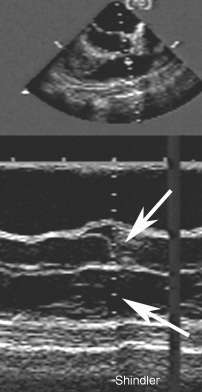
The finding of a new murmur on auscultation typically prompts an echocardiographic evaluation. There are exceptions: flow murmurs heard during pregnancy, typical innocent murmurs such as a venous hum, or a mammary souffle, usually do not require echocardiography. There are practice guidelines that describe the indications for echocardiography:

The auscultatory findings of aortic stenosis have some Doppler equivalents.
Doppler interrogation of the normal aortic valve produces a prominent
opening signal immediately following the QRS complex. The opening of the
non prosthetic aortic valve is usually inaudible on auscultation.
A second Doppler signal is evident when the normal aortic valve closes.
This is the equivalent of the aortic component of the second
heart sound. Absence of this aortic component of the second heart sound
indicates that the aortic leaflets have become immobile. This also becomes
evident with the Doppler examination of the stenotic aortic valve.
The duration and time-to-peak (but not the loudness) of the crescendo
decrescendo aortic ejection murmur are related to severity of aortic
stenosis. Similiarly, the contour and peaking of the Doppler flow
pattern through the stenotic aortic valve are useful indices of severity.
Daniel Shindler M.D.
 It is sometimes possible to use M-mode to simultaneously
display aortic and pulmonic valve closure. This is the
echocardiographic equivalent of the aortic and
pulmonic components of the second heart sound.
The timing of aortic and pulmonic valve closure
can also be measured separately by referencing
it to the QRS (as long as it is done in the same
phase of the respiratory cycle).
It is sometimes possible to use M-mode to simultaneously
display aortic and pulmonic valve closure. This is the
echocardiographic equivalent of the aortic and
pulmonic components of the second heart sound.
The timing of aortic and pulmonic valve closure
can also be measured separately by referencing
it to the QRS (as long as it is done in the same
phase of the respiratory cycle).
Back to E-chocardiography Home Page.

The contents and links on this page were last verified on November 20, 2006.